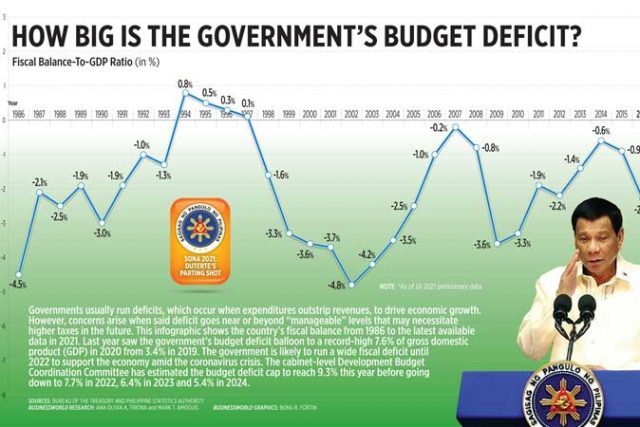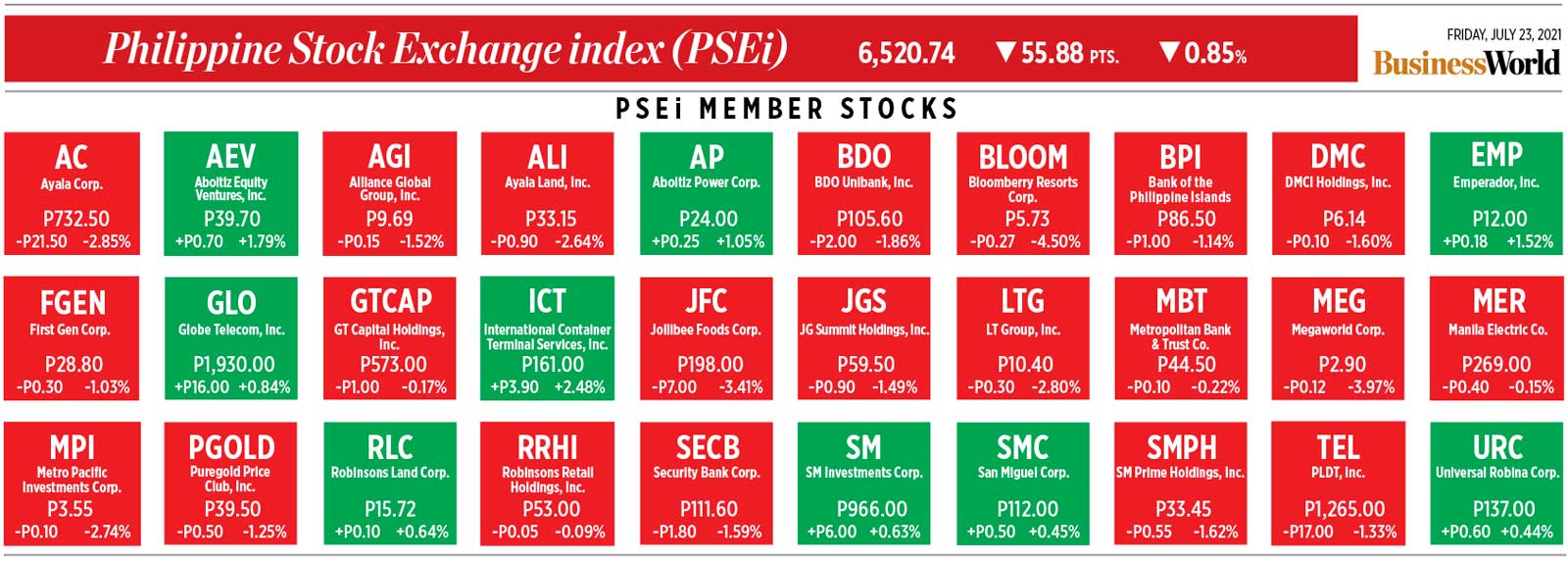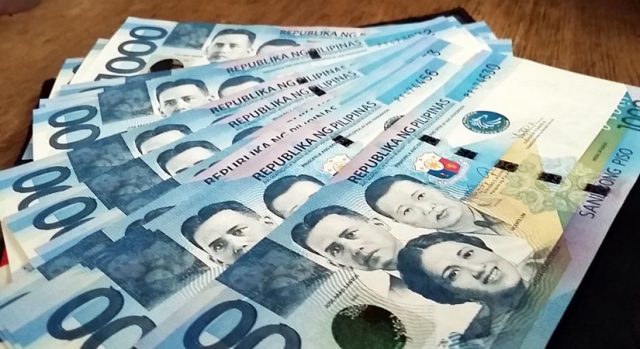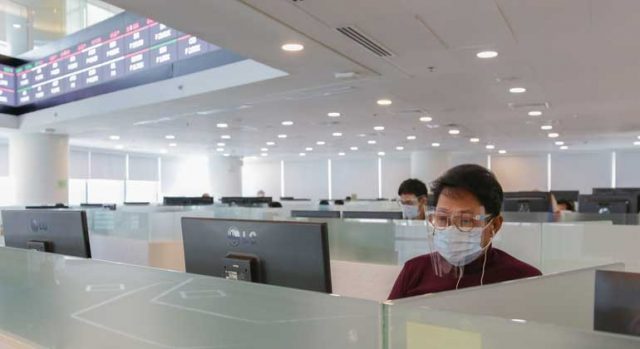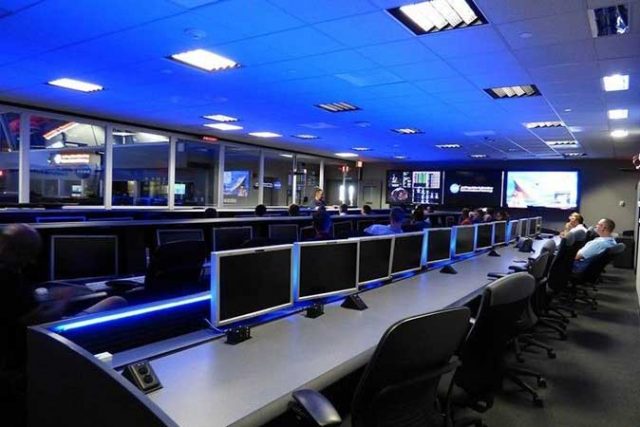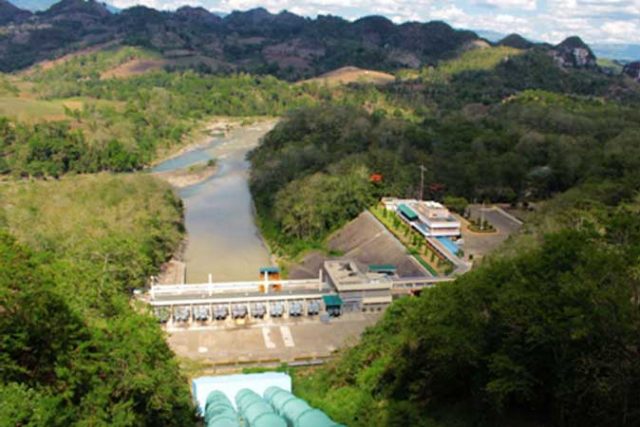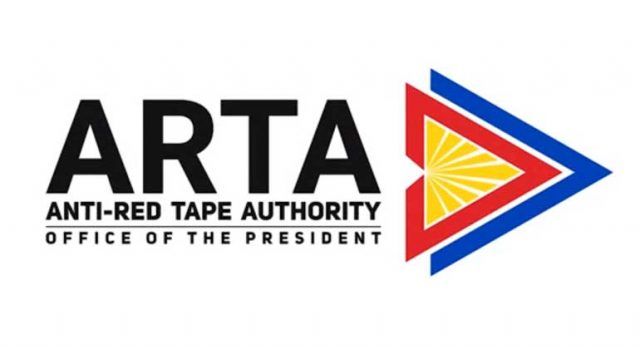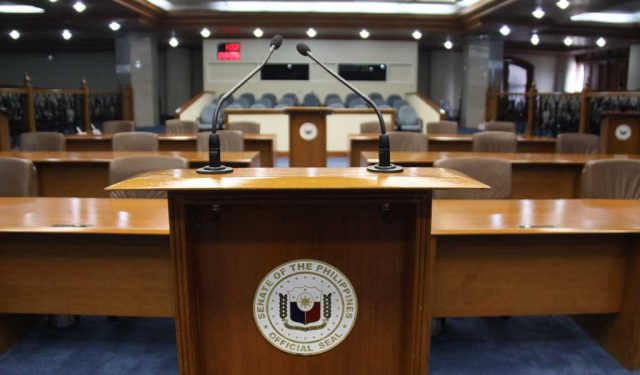Peso may weaken on virus worries, Fed meet
THE PESO may depreciate further versus the greenback this week as the market waits for clearer signs from the US Federal Reserve on its policy normalization and amid rising concern on the spread of the more contagious Delta variant of the coronavirus disease 2019 (COVID-19).
The local unit closed at P50.34 per dollar on Friday, losing 20.5 centavos from its P50.135 finish on Thursday, data from the Bankers Association of the Philippines showed.
The peso also weakened by P10.5 centavos from its P50.235-per-dollar close on July 16.
The peso weakened due to preference for the dollar amid rising concerns over the local transmission of the Delta variant, which resulted in the tightening of restriction measures, Rizal Commercial Banking Corp. Chief Economist Michael L. Ricafort said.
Metro Manila and some provinces on Friday were put under general community quarantine “with heightened restrictions” until July 31 to prevent the further spread of the highly infectious Delta variant.
The country’s travel ban on countries with rising cases of the variant has also been expanded to include Malaysia and Thailand.
The Health department on Saturday reported 17 new cases of the Delta variant, with 12 of which said to be local cases and one a returning overseas Filipino. The other four cases are still being verified. Three of these newly reported Delta variant cases are said to be active, while 14 have recovered.
The country now has a total of 64 Delta variant cases.
Heightened corporate demand for the dollar last week also pulled the peso down, UnionBank of the Philippines, Inc. Chief Economist Ruben Carlo O. Asuncion said.
For this week, Mr. Ricafort said the peso could weaken further as investor sentiment could take a hit from the increase in COVID-19 infections amid the local transmission of the Delta variant.
Mr. Asuncion said the market will also monitor the Federal Open Market Committee’s meeting on July 27-28 for clues on the timing of the tapering the Fed’s pandemic-driven asset purchases.
The Fed in June kept policy rates near zero to support economic recovery but said interest rate hikes may come as soon as 2022 or 2023, earlier than what was previously signaled.
For this week, Mr. Ricafort gave a forecast range of P50.05 to P50.45 per dollar, while Mr. Asuncion expects the peso to move within a stronger band of P50 to P50.40. — L.W.T. Noble
Stocks to move lower as Delta variant cases rise
SHARES could trade lower this week, with investors seen remaining cautious as the local transmission of the Delta variant of the coronavirus disease 2019 (COVID-19) dampens market sentiment.
The Philippine Stock Exchange index (PSEi) declined by 55.88 points or 0.85% to close at 6,520.74 on Friday, while the broader all shares index went down by 36.43 points or 0.89% to end at 4,038.51.
Week on week, the bellwether PSEi lost 173.09 points from its 6,693.83 close on July 16.
“The local bourse declined… as the government tightens once again the restrictions in Metro Manila and other provinces due to the Delta variant threat,” Philstocks Financial, Inc. Research Associate Claire T. Alviar said in a Viber message on Friday.
“We think that many investors now are staying on the sidelines monitoring the COVID-19 cases and the action of the government against the spread of the COVID-19,” she added.
The government on Friday placed Metro Manila and the provinces of Ilocos Norte, Ilocos Sur, Davao de Oro, and Davao del Norte under general community quarantine “with heightened restrictions” until the end of the month to help curb the spread of COVID-19.
The Health department on Saturday reported 17 new cases of the Delta variant, with 12 of which said to be local cases and one a returning overseas Filipino. The other four cases are still being verified. Three of these newly reported Delta variant cases are said to be active, while 14 have recovered.
The country now has a total of 64 Delta variant cases.
The market is expected to trade with a downward bias this week as fears over the spread of the more transmissible Delta variant of COVID-19 are likely to affect investor sentiment.
“If more confirmed local cases with the Delta variant are reported [this] week, then we may see heavy sell-offs in the market,” Philstocks Financial, Inc. Senior Research Analyst Japhet Louis O. Tantiangco said in a Viber message on Saturday.
“[This] is also expected to weigh on the market,” Mr. Tantiangco said. “This is due to the economic losses anticipated from the imposition of relatively tighter measures against the productive capacity of the biggest contributor to our GDP (gross domestic product).”
Mr. Tantiangco expects the benchmark index to trade at around 6,400 to 6,600, noting that “trading may remain lethargic.”
“Investors may continue to watch out for the second quarter corporate results for clues,” he added.
Meanwhile, Diversified Securities, Inc. Equity Trader Aniceto K. Pangan said the PSEi could move between 6,450 and 6,700.
“Market will continue its volatility with a downward bias as infection rates increased with the pandemic virus, [coupled] with the government doing ways to contain the spread of the virus through stricter measures,” Mr. Pangan said in a text message on Saturday. — Keren Concepcion G. Valmonte
Cebu BPOs see remote work arrangements in place for up to five years
A CEBU business process outsourcing (BPO) organization said it expects to continue with work-from-home arrangements for between two and five more years, and called for the accelerated rollout of telecommunications services to the countryside.
Cebu IT-BPM (Information Technology-Business Process Management) Organization President Exuperto P. Cabataña said in an e-mail last week that 60-75% of outsourcing staff could be assigned to work remotely for the foreseeable future.
“Therefore, we are pushing the telcos to accelerate addition of lines and network expansion outside the central business districts and well into the countryside.”
The government, he added, needs to fully digitalize its processes and assist telecommunications firms in speeding up the processing of their permits to set up internet infrastructure. Government agencies last year signed a joint circular that would streamline telco permit processing.
The Philippines has relatively low digital penetration rates. Last year it ranked 66th out of 85 countries in the 2020 Digital Quality of Life Index due to expensive, low-quality internet and poor electronic infrastructure.
The Cebu industry group’s revenue growth, representing about a tenth of the industry, is expected to be in line with national trends.
The Information Technology and Business Process Association of the Philippines last year reduced its projections to a 3.2-5.5% revenue compound annual growth rate, with an estimate of $27.88-$29.09 billion for 2022. Outsourcing revenue rose just 1.4% to $26.7 billion in 2020.
Mr. Cabataña said that there is slightly higher outsourcing growth in Clark and Iloilo, areas that are favored by locators planning expansions in places with more space and less congestion than Cebu.
“However, with the pandemic situation which is expected to last some 2-5 years more, the space advantage of Clark and Iloilo narrows as talent and skills again become more prioritized thereafter,” he said.
A partnership between the government and private sector last year identified 25 cities for outsourcing development, redirecting opportunities to cities like Batangas, Olongapo, and Zamboanga, which were chosen based on parameters identified as priorities for investors, including talent availability, infrastructure, cost, and business environment. — Jenina P. Ibañez
Gov’t return to power generation should not be ruled out, former official says
By Angelica Y. Yang, Reporter
THE DEPARTMENT of Energy’s proposal to embark on new power generation projects must not be dismissed outright due to the difficulty of balancing energy security and affordability, a former official of the National Renewable Energy Board (NREB) said.
“Perhaps the proposal is for government to engage or pursue new power generation projects — if so, I think this should be evaluated closely, resisting perhaps the temptation to immediately dismiss the idea,” Monalisa C. Dimalanta, former NREB chairperson, told BusinessWorld via Viber over the weekend.
“As we continue to define the path towards energy transition that addresses both our energy security requirements and affordability challenges, all hands really need to be on deck,” she added.
Energy Secretary Alfonso G. Cusi has asked the Senate Committee on Energy to consider allowing the government to engage in “limited” power generation — not to compete with the private sector — but to augment the grid’s reserves. The proposal would reverse a decades-long trend of power privatization.
Ms. Dimalanta said that the government remains in the power generation sector despite the Electric Power Industry Reform Act of 2001’s (EPIRA) privatization mandate.
“(The government) continues to hold a significant portfolio of the generation assets through PSALM (Power Sector Assets and Liabilities Management Corp.) that have not yet been privatized and through NPC (National Power Corp.) in the off-grid areas,” she said.
She added that allowing the government to re-enter power generation cannot solely address the country’s energy issues.
“Relying on government alone is not enough, particularly in taking on the huge challenge of energy security. (But the) government plays a big role as it (seeks to promote) proper governance and implementation of laws to create a stable investment climate… and by making sure it does not crowd out the private sector to ensure competition and a level playing field,” Ms. Dimalanta said.
If the government decides to go ahead with its proposed foray into power generation, it will have to revise the law, according to Alberto R. Dalusung III, who is currently the energy transition advisor of non-government organization Institute of Climate and Sustainable Cities.
“It would require amending EPIRA. They would have to amend the law… That means government (is) going back into generation. My understanding as a layman is, that’s not allowed under EPIRA (which states that there should be) no new government investments in generation,” Mr. Dalusung told BusinessWorld in a video call last week.
He said Mr. Cusi’s proposal indicates that the government intends to play a “supporting role” in power generation, and not compete with private firms in doing so.
At a Senate hearing on June 10, Mr. Cusi said government-owned power plants are best used for supplying emergency power when needed. He said that this arrangement could be the “antidote” to the National Grid Corp. of the Philippines’ repeated non-compliance with securing the needed firm-contracted reserves.
The Luzon grid was placed under a series of red and yellow alerts between May 31 and June 2, triggering rotating brownouts due to forced plant outages, thinning reserves and higher temperatures.
Mindanao hydropower project applications up for review soon
DAVAO CITY — Proposed hydropower projects in Mindanao will be up for assessment soon, in line with efforts to bring fossil fuel and renewable energy power sources into balance, according to an official with the Mindanao Development Authority (MinDA).
“We are anticipating, moving ahead (with) the resurgence or restarting of processes of any of the hydropower applications,” Assistant Secretary Romeo M. Montenegro, MinDA deputy executive director and technical working group head of the Mindanao Power Monitoring Committee, said in a recent virtual briefing.
Among the major pending applications are the 225-megawatt Agus 3 Hydro Power Plant by Maranao Energy Corp.
Mr. Montenegro told BusinessWorld the project’s declaration of commerciality is currently under evaluation by the Department of Energy.
It will be part of the Agus Hydropower Complex in Baloi, Lanao del Norte.
The overall rehabilitation plan for the Agus-Pulangi facility is also underway, with the proposal coming from the government-owned Power Sector Assets and Liabilities Management Corp. — Maya M. Padillo
PHL, Japan to meet again for infrastructure updates
ECONOMIC MANAGERS are set to meet with their Japanese counterparts this week to discuss the progress of Japan-backed infrastructure projects and the government’s pandemic response, the Department of Finance (DoF) said Sunday.
The DoF said in a statement that the upcoming 11th Japan-Philippines Joint Committee on Infrastructure Development and Economic Cooperation will meet July 28 to discuss the progress of key infrastructure projects under the Build, Build, Build program and other development initiatives.
Finance Secretary Carlos G. Dominguez III and Socioeconomic Planning Secretary Karl Kendrick T. Chua will lead the Philippine delegation to meet with Izumi Hiroto, special advisor to Japanese Prime Minister.
The Japan-funded infrastructure projects that will be discussed include the first phase of the Metro Manila Subway Project; the Metro Manila Priority Bridges Seismic Improvement Project; the North-South Railway Project; the Parañaque Spillway Project; the Philippine Railway Institute; and the rehabilitation of Metro Rail Transit 3.
They will also provide updates on the Central Mindanao Highway Project, the Davao City Bypass and New Clark City.
The two countries launched these talks in March 2017 to keep track of the implementation of infrastructure projects in the Philippines funded by Japan.
The two sides met virtually in October last year.
Next week’s meeting will also discuss last year’s loan to support the Philippines’ pandemic response worth $468.39, as well as the ongoing vaccination program.
The Japan International Cooperation Agency has released 40 billion yen so far from its 50 billion yen standby facility for the Philippines’ post-pandemic recovery efforts.
The Japanese government also donated more than one million AstraZeneca doses earlier this month.
Its support for the ongoing peace processes in Mindanao through the Japan-Bangsamoro Initiatives for Reconstruction and Development framework will likewise be tackled in the meeting, as well as their efforts to help in the rehabilitation of Marawi City.
Japan was the country’s top source of official development assistance active grants and loans worth $8.537 billion as of March 2020. This accounted for 42.66% of the Philippines’ foreign aid. — Beatrice M. Laforga
ARTA says agencies’ regulatory databases undergoing testing
THE ANTI-RED Tape Authority (ARTA) said tests are being run on the online regulatory management and government service databases systems of various agencies.
The initial phase of each platform is being tested by 62 National Government agencies and local government units to prepare for the rollout.
The agencies are testing the Philippine Business Regulations Information System, a web-based platform for real-time access to a regulatory management system.
The Anti-Red Tape Electronic Management Information System (ARTEMIS) is an online system for submissions of citizen’s charters that shows a real-time database of government services.
“ARTEMIS will facilitate the standardization of Citizen’s Charters, will enable government service reengineering through business process management features, and will allow citizens to access and download the Citizen’s Charters of all government agencies,” ARTA said in a statement Saturday.
The testing will run until Wednesday, and feedback from the participating agencies will be used to prepare for the official rollout of both systems this year.
Representatives from Bureau of Customs, Bureau of Internal Revenue, Civil Aviation Authority of the Philippines, Department of Agrarian Reform, Department of Foreign Affairs, and the Department of Information and Communications Technology are participating in the testing, along with various National Government agencies and the Quezon City Government.
“We are now in the home stretch of this administration and we would like to believe that before this administration ends, we will be able to set in place all the infrastructure needed so that the incoming administration. (It) will be easier for them to just continue the programs and initiatives that have been started with this administration,” ARTA Deputy Director General for Operations Ernesto V. Perez said. — Jenina P. Ibañez
Reimagining healthcare
A year and a half into the pandemic, we have seen how almost every industry has had to undergo rapid transformation in order to develop new methods of product and service delivery. One industry that has perhaps been forced to rapidly move beyond traditional processes is healthcare. In the Philippines, we have seen a dramatic shift to using technology to promote telemedicine and virtual healthcare to allow for personalized, effective and convenient healthcare in socially-distanced safety.
However, developments such as video or online consultations serve as a beginning, not an end point. Companies now have the opportunity to permanently transform how healthcare is delivered in a way that addresses the increased needs of care providers and their patients. To tackle the evolving needs of consumers, we look at three key areas identified in an EY article, Five trends redefining the health sciences and wellness operating model that companies should closely consider in their strategic focus and in the deployment of their human and financial capital and efforts.
DEVELOPING INTEGRATED SOLUTIONS AND PERSONALIZED HEALTH OUTCOMES
The current health infrastructure is provider-driven, supply-oriented and siloed, placing consumers in a disparate model. In the future, consumer demand will drive a seamlessly connected healthcare system with humans at the center, delivering a personalized and informed experience. Imagine, for example, a one-stop system where a patient only needs to use one platform for initial consultation, treatment, the delivery of medication and follow-up consultation, all with centralized medical record access.
While such a platform is yet to be developed, Philippine healthcare providers can start reimagining a future where technology and patient-centricity can drive a competitive advantage. Such a patient-centered model will require aggregated data that is shared to fully understand and more quickly respond to the needs and wants of a patient. Healthcare will have to take a more proactive role, bringing care to a patient instead of forcing a patient to spend time, money and energy searching for the care they need.
For companies to put humans at the center, they must partner or collaborate with companies to gain capabilities in user-centered design, behavioral science and services. They can also build or employ the services of experts in artificial intelligence and machine learning algorithms as well as interoperable system integration. Already there have been several developments around the world in using AI to provide personalized healthcare, such as the launch of a cloud-based platform by one company to help patients manage chronic disease by managing both medication and patient responses to the medication remotely. Another is developing a system to conduct liquid biopsy and remote monitoring so that patients do not have to go to a hospital and undergo invasive tests. Another system does real-time monitoring of patient biometrics, allowing for a quick response in case of a medical situation.
While such technologies may not be immediately available to Philippine healthcare providers, the continuing development of 5G technology and other innovations here could open the door to rich opportunities that healthcare providers can explore as part of their post-pandemic strategies.
OPENING UP ACCESS TO DATA
It has been estimated that humanity generates up to 2.5 quintillion bytes of data each day. For the healthcare industry, an estimated 50 terabytes of data were created in 2020 alone, and the number is expected to increase exponentially as the effects of the pandemic continue. However, having all the data means little if we cannot properly analyze the information. Most of the data generated by the healthcare industry sit in siloes every year, but the difficulty in extracting the information’s true and extended value lies in various technical and ownership issues as well as regulatory reluctance. In addition, most companies tend to be very protective of their data, considering the information a source of potential intellectual property assets and new discoveries.
However, the reality is that no single company is able to or should own more than a fraction of the total volume. At the same time, the monetary value of proprietary data is significantly less than the data that a company can actually access, interrogate and apply to the operations and product development. Simply owning data generates costs but accessing and assessing data can generate valuable insights for the health system. Moreover, refusing to share or grant access to data impedes meaningful progress in healthcare.
While this is certainly a thorny conundrum, it is something that the healthcare industry should explore. Two key questions come to mind: How can companies mine their data to get the right information that is critical to their business model, and how they can share access to their data with selected, tightly regulated partners so that more long-term value can be gained by combining resources, knowledge and insight?
Answering these will take time, investment, and no little amount of compromise. But consider the possible discoveries in such a situation. For example, a hospital that shares data on the most and least effective COVID-19 treatments and medication with a company that manufactures diagnostic machines might be able to develop more effective, life-saving technology. Or if we wish to consider recent news, there has been talk of combining various vaccine brands to achieve a greater protective effect — this is a potentially game-changing area where sharing and combining data could have incredible benefits.
Of course, companies will need to develop structured data system arrangements to protect proprietary data while allowing access to vetted companies. They will also need to work with government, regulators and data security experts to establish norms that are acceptable and fair to all parties and while protecting data integrity. In addition, healthcare companies may need to retrain or acquire talent that can develop proprietary data processing technologies to help speed up the R&D process.
BUILDING SUSTAINABILITY INTO OPERATIONS
An EY survey with almost 15,000 respondents discovered that up to 45% of consumers believe in the increased importance of sustainability compared to a year earlier. In the Philippines, we hear about the challenges that medical facilities and providers are now having in dealing with medical waste and used protective equipment. Consider as well the number of disposable syringes that are being consumed daily all over the world due to vaccination and we can better realize the increasing need for companies to measure and report sustainability practices tied to environmental, social and governance (ESG) disclosures.
Though it may seem obvious that products and services that help people treat or manage disease have significant social value, more and more people are also weighing the import of environmental and economic issues.
For companies to demonstrate their commitment to sustainability, they need to establish a measurement framework to gauge the impact of their sustainability programs based on their business model, and also be able to communicate the value of their sustainability initiatives to their patients, customers, stakeholders and investors.
ACCELERATED TRANSFORMATION FOR BETTER HEALTHCARE DELIVERY
COVID-19 has highlighted the gaps between what companies are capable of now and what they will need to accomplish for future growth. With the acceptance and adoption of new technologies fueled by data and driven by consumer demand, companies in the healthcare industry need to start reimagining how they can generate innovative, long-term value for their business and use that to springboard into post-pandemic recovery.
The pandemic is not the first, nor will it be the last, major disruption that will trigger forced transformation and evolution for companies. While we cannot predict what the future may bring, we can certainly reimagine how it should be.
This article is for general information only and is not a substitute for professional advice where the facts and circumstances warrant. The views and opinions expressed above are those of the author and do not necessarily represent the views of SGV & Co.
Karen Kaye M. Sta. Maria-Constantino is a Tax Partner of SGV & Co.
Targeted lockdowns sought amid Delta scare
By Kyle Aristophere T. Atienza and Luz Wendy T. Noble, Reporters
HEALTH authorities urged local governments at the weekend to enforce targeted lockdowns instead of region-wide border closures to save the economy while trying to contain a more contagious Delta coronavirus variant.
“It’s very important for local government units to implement strict lockdowns in cities or provinces as necessary,” said Anna Lisa T. Ong-Lim, chief of the Infection and Tropical Disease Division of the Philippine General Hospital and a member of the Health department’s technical advisory group.
“Given the economic impact of imposing region-wide lockdowns, the response strategies are anchored on imposing localized or granular lockdowns,” she told a televised news briefing attended by President Rodrigo R. Duterte.
Ms. Ong-Lim also urged local governments to boost their disease surveillance and healthcare capacity amid the local transmission of the Delta variant from India.
“We need to work on the premise that every case that’s now detected is Delta so that we can act accordingly,” she said. “The strategy to manage a possible surge is to ensure that the healthcare system is actually ready regardless of the community quarantine classification.”
An overwhelmed healthcare system would make it difficult for cities to fight the virus, Edsel T. Salvana, director of the Institute of Molecular Biology and Biotechnology at the National Institutes of Health-University of the Philippines Manila, told the same briefing.
“We know Delta is more transmissible, it’s potentially deadlier and can spread faster,” he said. “But it is beatable with our minimum health standards, face shields, face masks, physical distancing and of course, we have to vaccinate everyone.”
DoH reported 5,479 coronavirus infections on Sunday, bringing the total to 1.54 million. The death toll rose to 27,224 after 93 more patients died, while recoveries increased by 5,573 to 1.46 million, it said in a bulletin.
There were 54,262 active cases, 93.4% of which were mild, 1.2% were asymptomatic, 2.3% were severe, 1.63% were moderate and 1.4% were critical.
The agency said five duplicates had been removed from the tally, three of which were tagged as recoveries. Fifty recoveries were reclassified as deaths. Three laboratories failed to submit data on July 23.
Mr. Duterte last week approved a recommendation by an inter-agency task force to tighten quarantines in the National Capital Region (NCR) and other virus-hit areas until end-July. He also banned travelers from Indonesia and Malaysia.
Fifty-five more people got infected with the Delta coronavirus variant — said to be 60% more contagious than the Alpha variant from the United Kingdom — bringing the total to 119, the Department of Health (DoH) said on Sunday.
Thirty-seven were local patients, 17 were returning migrant Filipinos and one was still being verified, it said.
Fourteen of the 37 were in Southern Luzon, eight in Northern Mindanao, six each in the capital region and Central Luzon, two in the Davao Region and one in Ilocos
DoH said 94 more people got infected with the Alpha variant, bringing the total to 1,775. It added that 179 more people have been infected with the Beta variant from South Africa, bringing the total to 2,019.
SPIKE
Meanwhile, the OCTA Research Group from the University of the Philippines flagged rising infections in Manila, the capital and nearby cities.
The average number of daily cases in Metro Manila from July 18 to 24 increased to 897 from 627 a week earlier, it said in a report released on Sunday.
“The reproduction number in NCR continued to rise with new cases,” it said, noting that the reproduction rate in the region increased had to 1.29.
The capital region had an average of 897 new COVID-19 cases daily from July 18 to 24, 43% higher than a week earlier, it said. “The current trend in the NCR over the past week follows the trend from Feb. 14 to 21, when a surge was in its early stages.”
The positivity rate in the capital region increased to 7%, while hospital use and ICU use remained low, OCTA said.
Manila, Valenzuela, Makati, Caloocan and Las Piñas were experiencing rising infections. Valenzuela, Makati and Las Piñas were considered high risk areas.
OCTA also reported that Cagayan de Oro, where several cases of the Delta variant have been detected, “had a resurgence.” “Elsewhere in Mindanao, the trends in Davao City and General Santos have slowed down, although both are still classified as high-risk areas.”
OCTA said the reproduction number in Cebu City had increased to 1.9, while its daily infections have risen to 175.
“Elsewhere in Luzon, Laoag continues to be in near-critical state, with critical levels of infection, incidence and positivity rate,” it said. In Mariveles, Bataan, the trend in new cases has slowed, but local government units were still in critical risk.
OCTA said the average daily cases in the Philippines from July 18 to 24 had risen to 5,817 from 5,063 a week earlier.
Meanwhile, the country’s move to reimpose some restrictions was a necessary sacrifice to prevent another infection surge, analysts said.
“The costs incurred by this reinstatement of lighter quarantine protocols would create bigger benefits in the future as we are able to protect lives and prevent stricter quarantine protocols that will significantly slow down economic recovery,” Asian Institute of Management economist John Paolo R. Rivera said in a Viber message.
While the restrictions were a needed “trade off,” the uptick in Delta variant cases would affect the consumption-driven economy, said Michael L. Ricafort, chief economist at Rizal Commercial Banking Corp.
Philippine economic output shrank by a record 9.7% last year amid the pandemic, and recession was expected to continue for the fifth straight quarter after the economy fell by 4.2% in January to March.
Restaurant capacity was cut and gyms were ordered closed to contain infections. A curfew from 10 pm to 4 am was also reimposed. Children were again barred from going out.
Lawmakers to tackle bills seeking to ease limits on ownership
By Bianca Angelica D. Añago, Reporter
SENATORS will tackle economic bills that seek to ease foreign ownership limits, while congressmen will focus on bills on employment, education and pandemic recovery when Congress resumes sessions on Monday.
The Senate will prioritize measures seeking to amend the Public Service Act and Foreign Investment Act, Senate President Vicente C. Sotto III in a Viber message.
These bills were likely to be approved by August, Senate Majority Leader Juan Miguel F. Zubiri said in a Viber message.
Senators would also try to pass changes to the Retail Trade Liberalization Act by lowering paid-in capital requirements, he added.
Measures seeking to change the Public Service Act and Foreign Investment Act were both pending on second reading. The House of Representatives approved the changes to the first law in March 2020 and the second in Sept. 2019.
The bill seeking to amend the Public Service Act will open some public sectors to foreign ownership such as transportation and telecommunications.
Meanwhile, the bill that will amend the Foreign Investment Act will lower the required number of direct local hires for foreign companies.
Changes to the Retail Trade Liberalization Act were approved on third reading in May. The House of Representatives approved its counterpart measure in March 2020.
The Legislative-Executive Development Advisory Council identified these as priority measures by to be passed before Congress’ sine die adjournment on June 4. President Rodrigo R. Duterte certified the measures as urgent, which allows both Houses to pass these on second and third reading at one session.
Mr. Sotto said they would exert best efforts to pass other priorities such as the bill that seeks to create a department for migrant Filipinos, which was approved by the House of Representatives last year. Mr. Duterte has certified this as urgent and was among the bills targeted by the council to be passed by yearend.
“We also committed to finish the Department for Migrant Filipinos by August,” according to Mr. Zubiri.
Meanwhile, the majority floor leader said it might be better to incorporate the third stimulus package in the 2022 national budget. Congressmen in June approved on third reading the more than P400-billion third stimulus package.
He said the Senate might become too busy with the national budget and might not have time to discuss economic Charter change, which congressmen have approved.
Mr. Duterte on June 24 also urged the Congress to pass the administration’s last two tax reform measures under the Comprehensive Tax Reform Program. These are the Real Property Valuation and Assessment Reform Act and Passive Income and Financial Intermediary Taxation Act.
The House approved the two measures on third reading in 2019. The bills are pending at the Senate committee level.
Mr. Duterte remains popular, with a year left before his six-year term ends, said Maria Ela L. Atienza, a political science professor at the University of the Philippines.
“While our Constitution bars him from running again, his popularity and dominance may still contribute to having some of his priority bills passed into law,” she said in an e-mail. “Because it is also his last year, many of his allies would also like to make sure that some of these bills are passed into law as part of his so-called legacy.”
Ms. Atienza said the government should continue to improve its coronavirus pandemic response and boost the chances of his chosen presidential candidate at next year’s elections.
She noted that the fact that Mr. Duterte was considering running as vice president might be a strategy to remain relevant and threaten the “still weak opposition.”
Meanwhile, Party-list Rep. Enrico A. Pineda said his committee would push bills seeking to strengthen workers’ security of tenure, protect independent contractors in the film, television and radio entertainment industry, and promote the welfare of freelancers.
He said the committee would try to “strike a balance between labor and management.”
The House committee on public accounts would also review the Education department’s budget for textbooks, Quezon City Rep. and committee chairman Jose C. Singson, Jr. said.
Albay Rep. Jose Ma. Clemente S. Salceda also cited the need to create new revenue streams, such as through a well-regulated gaming sector.
“The week after the state of the nation address, I believe the House and the Senate will agree on a ratified version of the tax regime on Philippine offshore gaming operations,” he said.
The House would also prioritize proposed changes to Foreign Investment Act, Public Service Act and the Retail Trade Liberalization Act because as these will be “critical to increasing foreign direct investments and creating new jobs.”

